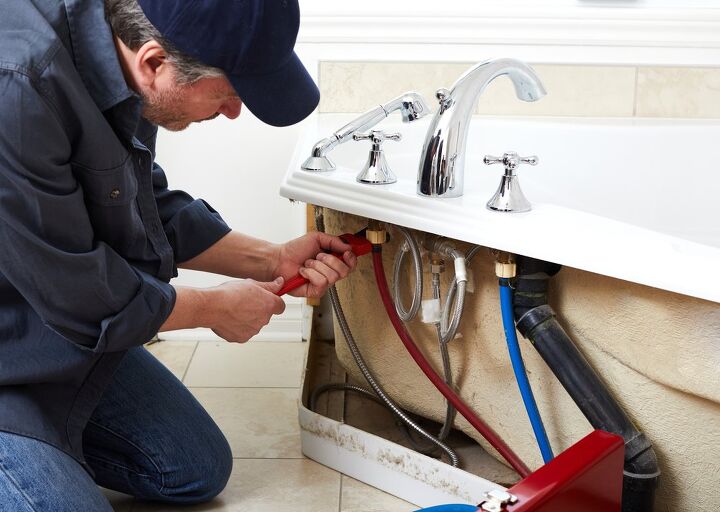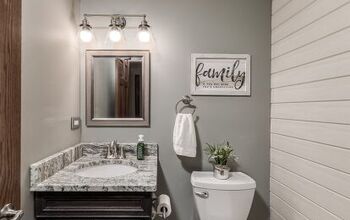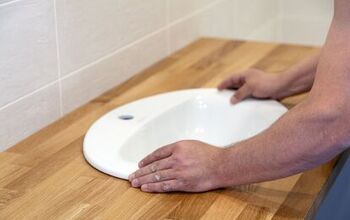How Much Does It Cost To Rough-In Plumbing For A Bathroom?

Rough-in plumbing in a bathroom could be a large project, especially if you have multiple bathrooms in your house. However, plumbing is one of the most critical pieces in your bathroom remodeling project. The investment will worth its while.
The average cost to rough-in plumbing for a bathroom is $6,000. Homeowners spend $225 per faucet rough-in, $2,900 for sinks, and $1,900 to rough-in a toilet. You will have to spend an additional $335 to relocate plumbing fixtures and $3.50 per square foot for plumbing pipes.
Many things could affect the cost of rough-in plumbing in your bathroom, including the quantity and category of fixtures being installed. We will go over all the details in the following sessions and save on your plumbing cost.
Do You Need to Hire a Plumber?
Get free, zero-commitment quotes from pro contractors near you.

The Lowest and Highest End of Bathroom Plumbing Cost
Like all remodeling projects, there is the lowest and the highest end of bathroom plumbing costs.
If all you have is a small half bath, you might only need to pay as low as $750. If you are remodeling a master bathroom and want the highest standards applied, you may face a $20,000 bill at the end.
Plumbing Rough-In Cost for a Bathroom
| National Average | $6,000 |
| Average Range | $2,000-$10,000 |
| Minimum | $700 |
| Maximum | $20,000 |
Make sure to communicate with whoever you hire upfront about your expectations and the scope of the project. This will avoid any unnecessary argument on pricing down the road.
What is Plumbing Rough-In?
A plumbing rough-in means you already have all water supply and drains prepped through rough holes with studs. Also, frames and pipe connections are completed as well. The only thing left was to install all the fixtures properly.
Rough-in must be completed before any inspector visits your home for the first time, as it is the final stage of plumbing and fixture installation. For the same reason, the rough-in should be your best effort following all specifications.
Rough-In Plumbing by Fixture Types
The critical factor that affects your plumbing cost is the type of fixture you plan on installing. Some necessary fixtures include:
- Faucet
- Sink
- Toilet
- Bathtub
- Bidet
- Shower
In the table below, we will cover the cost of basic fixtures. Of course, you can always add more amenities or appliances, such as washer and dryers, to your bathroom if you have space and the budget. Don’t limit your imagination!
Plumbing Cost by Fixtures (Material + Installation)
| Fixture | Price (Low) | Price (High) |
| Faucet | $225 | $475 |
| Sink | $300 | $5,500 |
| Toilet | $350 | $3,500 |
| Bathtub | $500 | $2,750 |
| Bidet | $1,500 | $2,900 |
| Shower | $1,500 | $3,500 |
Depending on the type of product you buy, you may be able to DIY plumbing on some. Otherwise, check with your local contractors and see if you can get a bundle discount on larger projects.
Cost to Install a Faucet
While some plumbers sell faucets and pull a commission out of it, most will ask you to purchase your own. Faucets range from $50 to $250 in general. Your contractor may charge a flat rate or an hourly rate for the installation project.
Sink Installation Cost
You can choose from vanity sinks, hanging sinks, consoles, and pedestal sinks. Brands and materials are the main factors affecting your final installation cost. On average, vanities with drop-in sinks are the most cost-effective option.
Cost to Install a Toilet
The make, model, and design of your toilet will affect the installation cost. There are a few options you can choose from:
- One-piece or two-piece toilets
- Pressure-assisted flushing or water-saving toilets
- Self-cleaning toilets
The requirements for plumbing requirements are slightly different between these styles, so make sure you let your contractor know the details of the toilet you want.
Cost to Install a Bathtub
Bathtub installations come with a range of association costs, depending on how you’d like them installed. In recent years, small, alcove installations that include both a shower and an air bath have gained much popularities.
Cost to Install a Bidet
More homeowners are favoring bidet in recent years for the convenience it brings to the bathroom. Most bidets are either stand-alone or wall-mounted and come with different faucet configurations.
Cost to Install a Shower
When it comes to any shower, there are three basic elements related to plumbing: a single valve, showerhead, and drain. Depending on the make and model, there may be additional plumbing needs.
Plumbing Cost for Moving Bathrooms
Many homeowners use bathroom remodeling as the time to revamp the layout as well. This changes foot traffic and provides new possibilities to your interior. Sometimes it also makes your living more efficient and comfortable.
In the case of moving appliances, the biggest cost comes from the need to redesign the pipelines. There are a few cost items when it comes to roughing-in plumbing for a moving bathroom:
- Relocating washers or any other major appliances, such as washers, showers, or toilets
- Moving a plumbing stack
- Moving or adding lines in concrete slabs
- Moving plumbing from one wall to another
Appliance Relocation Cost
To change the foot traffic in your bathroom for more efficiency, many homeowners will decide to relocate some appliances.
If you have a washing machine in the bathroom, relocation will require a new plumbing line. This could cost you $170 to $500. Also, most plumbers don’t do the actual installation as they are not certified to do so.
If you are moving a toilet, you need a new water line and a new waste line. This typically costs $200 to $400, not including the installation.
If you are moving a sink or installing a new sink, you also need new lines installed. Each sink requires three lines, and the cost ranges from $540 – $6,100, including installation.
Moving a Plumbing Stack
A plumbing stack is how your plumbing system vents. For example, low flow toilets will use this line to vent air and create a vacuuming pull before the flush. Moving a plumbing stack costs $250 to $450 on average, but maybe more expensive if you have a steep roof.
Plumb Lines in Concrete
Moving or installing plumb lines into concrete is one of the most expensive plumbing costs because additional work is involved in breaking and restoring the concrete slab.
Depending on the slab’s thickness, plumbing depth, and plumbing type, moving lines in concrete usually cost $550 to $1,500, including all materials.
Moving Plumbing from One Wall to Another
You will need to move lines from one wall to another when you are relocating your shower. This includes the hot water, cold water, and the drain line. To move and install a new shower it usually costs $1,740 to $4,100.
Plumbing Cost for a Tower-to-Tub Conversion
A standard upgrade during bathroom remodeling is a tub-to-shower conversion. The conversion costs about the same as installing a new shower. However, if you’d prefer to remove the tub and put in a new shower, you will pay an extra $100 to $500.
Cost to Rough-In Plumbing by Materials
Another factor that affects the cost of rough-in plumbing for a bathroom is the type of pipes you use. In most cases, a plumber will either use PEX Pipes or copper pipes.
However, if you have an old house, you may need to remove pipes buried before due to environmental and safety considerations.
Polybutylene & Lead Pipe Replacement
Depending on how many bathrooms you have, expect to pay $2,500 to $15,000 to completely replace your polybutylene or lead pipe system.
Polybutylene pipes are outdated and extremely fragile. It is a severe safety hazard and should be taken out as soon as you can. In the meantime, it is mandatory that you replace lead pipe systems because of the latest EPA requirements. You should also test your water for lead content after replacement.
Galvanized Pipes Replumbing
Some older houses come with a galvanized pipe system. These pipes tend to rust and creating clogs. In return, they eventually lower the water pressure and make the plumbing less efficient.
Most plumbers will only recommend you to replace any visible galvanized pipes. However, it is best to completely replace the system because any corroded pipes could lead to severe water damage.
Copper Pipes
Copper is the most common option used nowadays. It costs $2 to %5 per foot or $5,000 to $20,000 for a full repiping. Copper pipes are the safest option that has been tested over the decades. However, copper pipes could burst in freezing weather, and therefore, additional winterization is necessary.
PEX Pipes
Roughing-in PEX pipes in your house cost about $2,000 to $5,000 less than traditional copper pipes. They don’t leak or burst because they are more flexible. It is also more energy-efficient because the PEX material retains heat better.
The downside is that PEX Pipes have a much shorter lifespan. Considering it was ultimately made of plastic, rodents in your house may be able to chew through them eventually.
An alternative to PEX is CPVC pipes. These usually cost $0.50 to $1 per foot. They are rigid but are more long-lasting. However, CPVC pipe quality could vary quite drastically.
Replumbing a Mobile Home
What if your bathroom is your home? Better yet, what if you live in a mobile home?
Most mobile home plumbing systems use PEX because it is light, affordable, and flexible. Also because mobile homes are often less winterized for cold weathers, in which copper pipes will burst.
Depending on your mobile home’s size, the cost of replumbing goes from $1,500 to $4,000.
DIY Rough-In Plumbing
Since rough-in plumbing is the last step in the process, a skilled homeowner can handle this by himself.
The Wastewater System
The first step will be laying out the pipes for the wastewater system since it is the largest piece in the plumbing project. It is always easier to add in smaller lines around the big one instead of the other way around.
Your wastewater system should include venting for the pipes, which is usually a pipe that goes upward through the roof. You also need a U-shaped pipe filled with water at all times for each fixture. This serves as a trap that prevents sewer gas from entering the living space.
Water Supply Pipes
The next thing is to lay out the water supply pipes. If you don’t need to remove any old pipes, feel free to choose copper or PVC pipes, and do the layout yourself. Otherwise, it’s best to hire a professional.
A Quick Step-By-Step Guide
To officially begin the rough-in process, follow these steps.
Step One: Mark Key Locations
Where do you want your toilet, sink, vanity, and bathtub to be? Mark out these locations using blue tapes for corners and flanges, then trace alongside the bottom of your fixture.
Step Two: Cut the Drain Hole
Cut out the marked section. Screw the bottom of your fixture into the floor.
Step Three: Drain Pipe Installation
Since you only have sub-floors during the rough-in phase, there would be no problem of placing pipes under the floor. Direct the drain to the waste stack with the right fittings.
This is one of the more complicated steps.
Step Four: Supply Line Installation
The last thing left to do is running your supply line. Run the line through either the floor or a wall, then attach it using a “T” fitting to the fixture.
Remember, DIY plumbing also needs to be approved by a building inspector. Therefore, if you are not 100% confident in your abilities, it’s best to hire a licensed plumber.
Tips on Hiring the Right Plumber
You don’t need to sacrifice quality to save on plumbers. Below are a few ways you can save on plumbing costs while hiring the right person for the job:
- Shop beforehand. Emergency jobs cost more and leave you with less time to shop around. If you’ve talked to different plumbers and have built a relationship with them, it is much easier to get a fair quote.
- Put everything in writing. You should always get a written estimate, whether done via digital signature or hard copies. Never go with verbal promises.
- Try to stay in regular hours. Holidays, weekends, and after-hours usually come with an upcharge.
- First-hour fees. Many companies charge a higher first-hour rate for showing up. If you are hiring someone further away, they may also charge a transportation fee.
- Ask for their license. Not everyone who claims to be licensed is licensed. Ask for a solid proof before signing any contract. You may also want to ask about their warranty policies upfront. Having that conversation on-site is far more complicated.
- Consolidate multiple jobs. If possible, bundle up plumbing jobs into one. This gives you more negotiation ground to ask for a “bundle discount.” Also, if any other issues come up during the project, for example, your kitchen faucet began to leak while someone was working in the bathroom, check with your contractor.
In general, leave no stone unturned when it comes to plumbing. It’s always better to be safe than sorry, considering how costly water damage remediation could be.
Do You Need to Hire a Plumber?
Get free, zero-commitment quotes from pro contractors near you.

Relative Questions
Yes. There are a few types of additional cost depending on your project and the condition of your bathroom, including:
- Mold remediation
- Water damage restoration
- Drywall removal and repair
- Ceiling removal and repair
If you can complete some of these tasks yourself, for example, ripping out the drywall independently, that will save you a lot on the total cost.
How much does it cost to move plumbing in a bathroom in general?The best way to calculate moving plumbing costs is going by the national average per-line cost. As of 2020, the cost to move a plumbing line is between $80 to $200. Most bathroom fixtures require at least three lines. Therefore, you are looking at $240 to $600, not including installation.
On average, how much does it cost to replumb a house?A regular home is about 2,500 square feet large and has 2 to 2.5 bathrooms. In that case, the cost of rough-in plumbing is approximately $11,500 on average.
If I purchase all the fixtures myself, will I save more money?In most cases, yes. Or you should at least purchase the sink, faucet, and vanities yourself. You can even rough-in some simple plumbing yourself, such as for vanities.
How much would a new construction plumbing cost?If you are roughing-in plumbing for new construction, you will pay approximately $4.5 per foot. However, most projects are bid at a flat rate or hourly rate. So make sure you calculate the cost beforehand before asking for proposals.
What is the rough-in height for a bathroom sink drain?Typically, the sink drain is between 24 inches above the floor.
Can my shower and toilet share the same drain?Yes and no. It’s okay for the shower and the toilet to share the same drain, as long as your shower is not connected to the toilet’s trap arm. So the shower connection needs to remain downstream from the toilet vent.
Do I pay for the plumbing inspection?Plumbing inspectors usually charges $165 per visit. If you are selling your house, talk to your agent, and see if the buyers are paying for the inspection. Otherwise, you need to pay the inspection out of your pocket.
Related Guides

With a deep passion for content and creative writing, Xiao Faria da Cunha finds a strong sense of accomplishment in creating quality home guides that resonate with homeowners. When not writing, you can find Xiao creating art masterpieces.
More by Xiao Faria Da Cunha



























